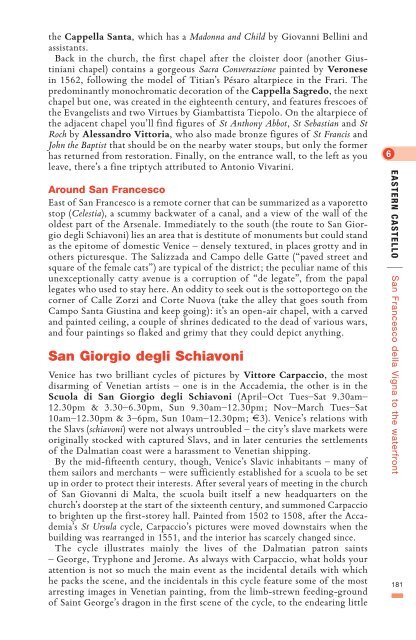Create successful ePaper yourself
Turn your PDF publications into a flip-book with our unique Google optimized e-Paper software.
<strong>the</strong> Cappella Santa, which has a Madonna <strong>and</strong> Child by Giovanni Bellini <strong>and</strong><br />
assistants.<br />
Back in <strong>the</strong> church, <strong>the</strong> first chapel after <strong>the</strong> cloister door (ano<strong>the</strong>r Giustiniani<br />
chapel) contains a gorgeous Sacra Conversazione painted by Veronese<br />
in 1562, following <strong>the</strong> model of Titian’s Pésaro altarpiece in <strong>the</strong> Frari. <strong>The</strong><br />
predominantly monochromatic decoration of <strong>the</strong> Cappella Sagredo, <strong>the</strong> next<br />
chapel but one, was created in <strong>the</strong> eighteenth century, <strong>and</strong> features frescoes of<br />
<strong>the</strong> Evangelists <strong>and</strong> two Virtues by Giambattista Tiepolo. On <strong>the</strong> altarpiece of<br />
<strong>the</strong> adjacent chapel you’ll find figures of St Anthony Abbot, St Sebastian <strong>and</strong> St<br />
Roch by Aless<strong>and</strong>ro Vit<strong>to</strong>ria, who also made bronze figures of St Francis <strong>and</strong><br />
John <strong>the</strong> Baptist that should be on <strong>the</strong> nearby water s<strong>to</strong>ups, but only <strong>the</strong> former<br />
has returned from res<strong>to</strong>ration. Finally, on <strong>the</strong> entrance wall, <strong>to</strong> <strong>the</strong> left as you<br />
leave, <strong>the</strong>re’s a fine triptych attributed <strong>to</strong> An<strong>to</strong>nio Vivarini.<br />
Around San Francesco<br />
East of San Francesco is a remote corner that can be summarized as a vaporet<strong>to</strong><br />
s<strong>to</strong>p (Celestia), a scummy backwater of a canal, <strong>and</strong> a view of <strong>the</strong> wall of <strong>the</strong><br />
oldest part of <strong>the</strong> Arsenale. Immediately <strong>to</strong> <strong>the</strong> south (<strong>the</strong> route <strong>to</strong> San Giorgio<br />
degli Schiavoni) lies an area that is destitute of monuments but could st<strong>and</strong><br />
as <strong>the</strong> epi<strong>to</strong>me of domestic <strong>Venice</strong> – densely textured, in places grotty <strong>and</strong> in<br />
o<strong>the</strong>rs picturesque. <strong>The</strong> Salizzada <strong>and</strong> Campo delle Gatte (“paved street <strong>and</strong><br />
square of <strong>the</strong> female cats”) are typical of <strong>the</strong> district; <strong>the</strong> peculiar name of this<br />
unexceptionally catty avenue is a corruption of “de legate”, from <strong>the</strong> papal<br />
legates who used <strong>to</strong> stay here. An oddity <strong>to</strong> seek out is <strong>the</strong> sot<strong>to</strong>portego on <strong>the</strong><br />
corner of Calle Zorzi <strong>and</strong> Corte Nuova (take <strong>the</strong> alley that goes south from<br />
Campo Santa Giustina <strong>and</strong> keep going): it’s an open-air chapel, with a carved<br />
<strong>and</strong> painted ceiling, a couple of shrines dedicated <strong>to</strong> <strong>the</strong> dead of various wars,<br />
<strong>and</strong> four paintings so flaked <strong>and</strong> grimy that <strong>the</strong>y could depict anything.<br />
San Giorgio degli Schiavoni<br />
<strong>Venice</strong> has two brilliant cycles of pictures by Vit<strong>to</strong>re Carpaccio, <strong>the</strong> most<br />
disarming of Venetian artists – one is in <strong>the</strong> Accademia, <strong>the</strong> o<strong>the</strong>r is in <strong>the</strong><br />
Scuola di San Giorgio degli Schiavoni (April–Oct Tues–Sat 9.30am–<br />
12.30pm & 3.30–6.30pm, Sun 9.30am–12.30pm; Nov–March Tues–Sat<br />
10am–12.30pm & 3–6pm, Sun 10am–12.30pm; e3). <strong>Venice</strong>’s relations with<br />
<strong>the</strong> Slavs (schiavoni) were not always untroubled – <strong>the</strong> city’s slave markets were<br />
originally s<strong>to</strong>cked with captured Slavs, <strong>and</strong> in later centuries <strong>the</strong> settlements<br />
of <strong>the</strong> Dalmatian coast were a harassment <strong>to</strong> Venetian shipping.<br />
By <strong>the</strong> mid-fifteenth century, though, <strong>Venice</strong>’s Slavic inhabitants – many of<br />
<strong>the</strong>m sailors <strong>and</strong> merchants – were sufficiently established for a scuola <strong>to</strong> be set<br />
up in order <strong>to</strong> protect <strong>the</strong>ir interests. After several years of meeting in <strong>the</strong> church<br />
of San Giovanni di Malta, <strong>the</strong> scuola built itself a new headquarters on <strong>the</strong><br />
church’s doorstep at <strong>the</strong> start of <strong>the</strong> sixteenth century, <strong>and</strong> summoned Carpaccio<br />
<strong>to</strong> brighten up <strong>the</strong> first-s<strong>to</strong>rey hall. Painted from 1502 <strong>to</strong> 1508, after <strong>the</strong> Accademia’s<br />
St Ursula cycle, Carpaccio’s pictures were moved downstairs when <strong>the</strong><br />
building was rearranged in 1551, <strong>and</strong> <strong>the</strong> interior has scarcely changed since.<br />
<strong>The</strong> cycle illustrates mainly <strong>the</strong> lives of <strong>the</strong> Dalmatian patron saints<br />
– George, Tryphone <strong>and</strong> Jerome. As always with Carpaccio, what holds your<br />
attention is not so much <strong>the</strong> main event as <strong>the</strong> incidental details with which<br />
he packs <strong>the</strong> scene, <strong>and</strong> <strong>the</strong> incidentals in this cycle feature some of <strong>the</strong> most<br />
arresting images in Venetian painting, from <strong>the</strong> limb-strewn feeding-ground<br />
of Saint George’s dragon in <strong>the</strong> first scene of <strong>the</strong> cycle, <strong>to</strong> <strong>the</strong> endearing little<br />
eastern castello<br />
|<br />
San Francesco della Vigna <strong>to</strong> <strong>the</strong> waterfront<br />
181







